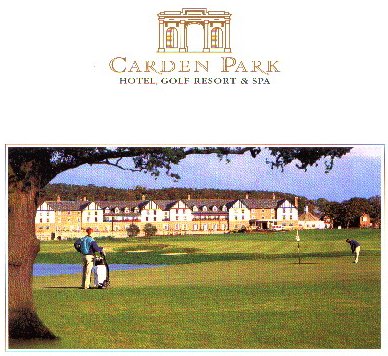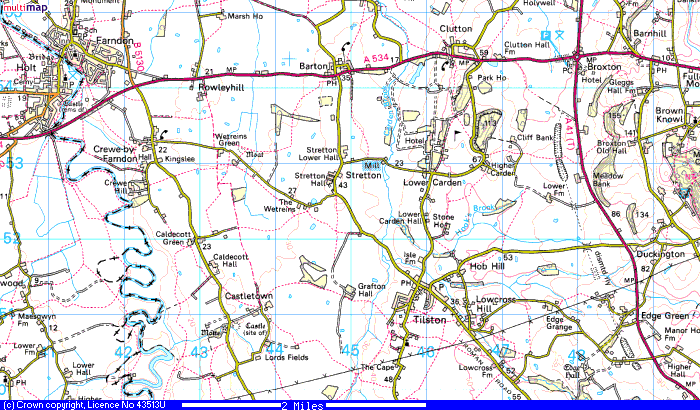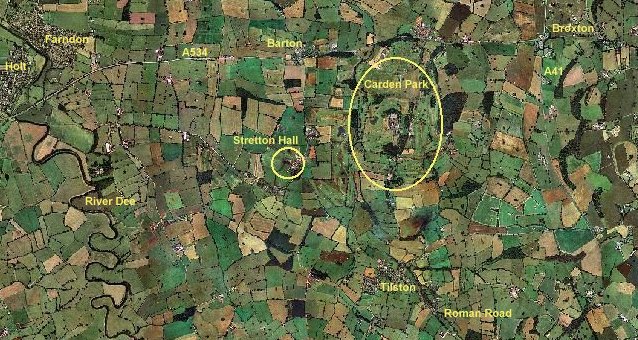CARDEN HALL AND PARK
Conceived and built in the 18th century, Carden Park, situated about 13 km (8 miles) to the south of Chester (53° 4'27.71"N 2°48'28.01"W), in the western Cheshire lowlands, is ranked amongst the nation's greatest Country Estates; however, its fascinating history goes back much earlier, to 1346, when the first John Leche received a grant of lands in Carden.His son, also John, became Leech, or Surgeon, to Edward III. Thus began the fortunes of the house of Leche. Four generations later, by intermarriage with the de Cawarden family, landowners in Carden since the early 13th century, the Leches established a double title to the lands of Carden, of which some 1,300 acres still remain as part of this magnificent Estate.
Successive generations of John Leches inhabited Carden Park, the first hall dating from the late sixteenth or early seventeenth century. On 16 June 1643, the house was plundered by Parliament troops, a woman servant was killed and John Leche and some of his household were taken prisoners to the garrison at Nantwich. However, luck was on the Leches' side and their lands and possessions were returned with the restoration of the Monarchy in 1660.
The late 18th Century saw significant investment taking place. Some time between 1777 and 1819, William Leche (the only heir not to have borne the name of John) converted the area around Carden Hall to parkland. William Leche lived at the Hall, while his eccentric neighbour, the hermit John Harris, owner of estates in Handley, Broxton and Tattenhall, for some 20 years occupied a cave in Carden Park with his servant John Barlow. Born in 1710, Harris lived to be 100. For further detail, see www.shef.ac.uk/~capra/1/hermit.html
A vast amount of money was spent on adorning the park with the opulence expected of such a prominent family seat. The superb gates were created to form a ceremonial entrance for the stream of high society and Royal visitors who came to the many extravagant weekend parties.
The Hall was renovated in the early 19th century and for some years was tenanted by Colonel George Holdsworth and Mrs Holdsworth, who restored the old style of country hospitality with regular visits from Royalty. It was following one of these occasions in the early hours of Monday 16 September 1912, that a fire broke out and within three short hours the Hall and all the treasures within were destroyed. It was rumoured at the time to have been started by a minor Royal carelessly dropping a cigarette, although the cause was never fully established.
Prints, photographs and descriptions of the Hall have survived. These show a highly decorated timber-framed building on sandstone foundations. After the fire in 1912, only these footings, together with a brick wine cellar and a small sandstone cellar survived on the site.
 After lying derelict for many years, the centre of the Estate came up for sale in 1987 for the very first time. The buyer needed to be someone with vision to see how the estate could be restored to its former glory. John Broome rose the challenge and the enormous programme of restoration began using highly skilled craftsmen. Work began on rebuilding the Estate roads, these being surfaced with red granite stone chippings, in keeping with the historical park atmosphere. Miles of sandstone walling was repaired, after 75 years of neglect, so that once again a herd of the famous Red Deer could run free at Carden Park. The Estate Cottages, the Shooting Lodge, the Coach House, the Monument and the magnificently imposing Golden Gates have all been painstakingly restored to their former glory.
After lying derelict for many years, the centre of the Estate came up for sale in 1987 for the very first time. The buyer needed to be someone with vision to see how the estate could be restored to its former glory. John Broome rose the challenge and the enormous programme of restoration began using highly skilled craftsmen. Work began on rebuilding the Estate roads, these being surfaced with red granite stone chippings, in keeping with the historical park atmosphere. Miles of sandstone walling was repaired, after 75 years of neglect, so that once again a herd of the famous Red Deer could run free at Carden Park. The Estate Cottages, the Shooting Lodge, the Coach House, the Monument and the magnificently imposing Golden Gates have all been painstakingly restored to their former glory.This was just the beginning of a massive renovation programme, involving the construction of two golf courses and a driving range in the early 1990s (see www.devereonline.co.uk/hotel_carden/), and culminating in the rebuilding of a new Carden Hall.
In June 1997 Carden Park Hotel opened and is now owned by De Vere's Hotels.
For more detail on the history of Carden Park, see Keith Matthews' site:
http://users.lunet.ac.uk/kmatthews/carden1.html .
Below are a map and aerial view of the immediate vicinity:

